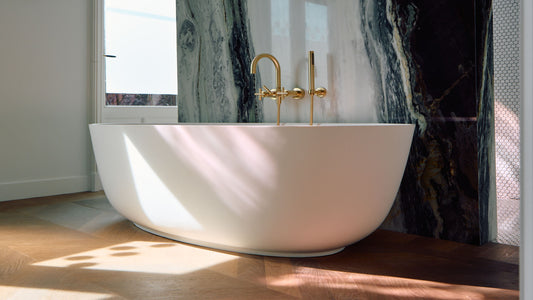Laminaatvloer

Datum: 24 augustus 2023
Leestijd: 6 minuten
Auteur: Uipkes Houten Vloeren
Laminate floors have acquired a special place in the world of interior design and architecture. Their versatility, durability and aesthetic appeal make them a popular choice for many homeowners and businesses. This essay discusses the history, development, future and sustainability aspects of laminate flooring.
Bezoek de showroom
History
Laminate flooring was first introduced in the late '70s and early '80s as a cheaper alternative to hardwood and tile floors. They were initially seen as a budget-friendly option, but technological advancements have transformed them into a product that can compete with other high-end flooring materials.
Development
In the early years, laminate consisted of simple layers of plastic with an image of wood or stone. Over time, construction methods have evolved to include more durable and realistic designs. Today, a typical laminate floor consists of four layers:
- Support layer: This layer provides structural stability and protects against moisture.
- Design layer: This is the layer on which the visual design is placed, usually a photographic print.
- Core layer: Made of fiberboard, this layer provides extra stability.
- Protective layer: This transparent layer protects against scratches and wear.
Inspiratie & Informatie
production
The production of laminate flooring involves several steps, including laminating, cutting and packaging. The core components are usually derived from wood chips, making the product relatively environmentally friendly compared to fully synthetic flooring materials.
Influence On The Climate
Although laminate floors are less environmentally damaging than some other materials, they still have an environmental impact, especially during the production phase. The adhesives and resins used can emit volatile organic compounds (VOCs), which contribute to air pollution. In addition, the extraction of raw materials and the eventual disposal of the floor can contribute to environmental pollution.
Application options
Laminate floors are ideal for use in a variety of environments, including homes, offices and shops. Their resistance to wear and moisture makes them a good choice for kitchens and bathrooms. In addition, special types of laminate have been developed for use in commercial areas with high traffic.
Adviesgesprek bij jou thuis?
Patterns Of Laminate Flooring
- Wood Look: One of the most popular choices, these floors imitate various types of wood, such as oak, maple and cherry.
- Tile and Stone Look: These are designed to look like marble, slate, or ceramic tiles.
- Abstract Designs: These include geometric and other artistic patterns.
- Fabric look: Some laminate floors are designed to look like fabric, complete with texture and weave patterns.
To colour
- Natural Tones: Brown, beige and cream are classic choices.
- Grayscale: For a more modern look.
- Dark Shades: Black and dark brown for a luxurious look.
- Vibrant Colours:** For a more daring and creative approach, there are laminate floors in bright colors such as red, blue and green.
Suitability for underfloor heating and cooling
Laminate is generally compatible with underfloor heating , but there are some considerations:
Thickness:** A thinner laminate floor will conduct heat better.
Thermal resistance:** It is important to choose a floor with a low thermal resistance for more efficient heating.
Installation:** The underlay must also be compatible with underfloor heating .
Floor cooling
Underfloor cooling with laminate is less common and can present some challenges:
Condensation:** Moisture can form between the floor and the underlay.
Energy efficiency:** Laminate is not as efficient at conducting cold as other materials, such as tiles.
Manufacturer specifications:** Not all laminate floors are suitable for underfloor cooling, so it is important to consult the manufacturer's specifications.
Magazine Vol inspiratie
Future
The future of laminate floors looks promising. With the advent of digital printing techniques and more advanced materials, we can expect an even greater diversity of designs and more sustainable products. Research is also being done into recycling laminate floors to minimize their environmental impact.
Conclusion
Laminate floors have evolved over the years from a budget-friendly choice to a full-fledged competitor to other flooring materials such as hardwood, tile and even stone. Their diversity in patterns and colors offers design freedom to suit different aesthetic preferences, from traditional to modern interior styles. This makes laminate one of the most adaptable flooring options on the market. In terms of functionality, laminate floors are generally compatible with underfloor heating systems, making them a comfortable and practical choice for modern homes. However, compatibility with underfloor cooling is still a challenge that requires further attention. It is therefore crucial to thoroughly consult the manufacturer's specifications and recommendations before proceeding with installation. Sustainability remains a concern, but it is also an area where much progress has been made. The use of recycled materials, improved manufacturing methods and research into end-of-life recycling options are steps towards a greener and more sustainable future for laminate flooring. While there are still environmental and technical challenges to overcome, continued innovations very promising in the laminate industry. These developments can further enhance laminate's potential, both as an aesthetically pleasing and functional flooring choice. In short, laminate flooring offers a versatile, more durable and aesthetically pleasing option for a variety of spaces and applications. With the right choices and considerations, they can be a long-term investment that adds comfort, beauty and functionality to any living space. Following the manufacturer's guidelines and recommendations will not only result in a successful installation but also help maximize the life and durability of the product.
Kom Langs In
Stay up to date with news about floors and interior


